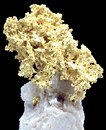|
|
| Formula: | Au |  Click to see a larger image |
||
| Crystal: | Isometric | |||
| Hardness: | 2.5-3 | |||
| Spec. Gr.: | 19.3 (pure) | |||
| Streak: | golden-yellow (pure) | |||
| Cleavage: | None | |||
| Location: | Alleghany, Sierra County, California |
| The Alleghany gold district was discovered by a group of Hawaiian sailors who found nuggets in Kanaka Creek. The Original Sixteen to One, a quartz gold mine, was discovered in 1896. It expanded by buying the Twenty-One and the Tightner mines. It remained a working mine for 69 years until it closed in 1965, after producing $35,000,000 in rich gold ore. Few gold specimens were saved, although some were indeed beautiful, because all of the bullion mined was needed to pay operating costs. The mine ultimately reached the 3000-foot incline level, but by that time the ore was no longer rich. The precious metal attracted people from near and far; all kinds of characters, all classes of people, miners, and even those who had no idea of mining. In 2000 the Sixteen to One mine had reopened and is currently working on a limited scale. |
|
Bibliography: Wagner, Jack R., Gold Mines of California, 1970, pg. 231-243. Wolfgang, Paul, Mining Lore. |
|
University of California, Santa Barbara—Department of Earth Science Copyright © 2005 Regents of the University of California Send your comments to the Web Page Editor |